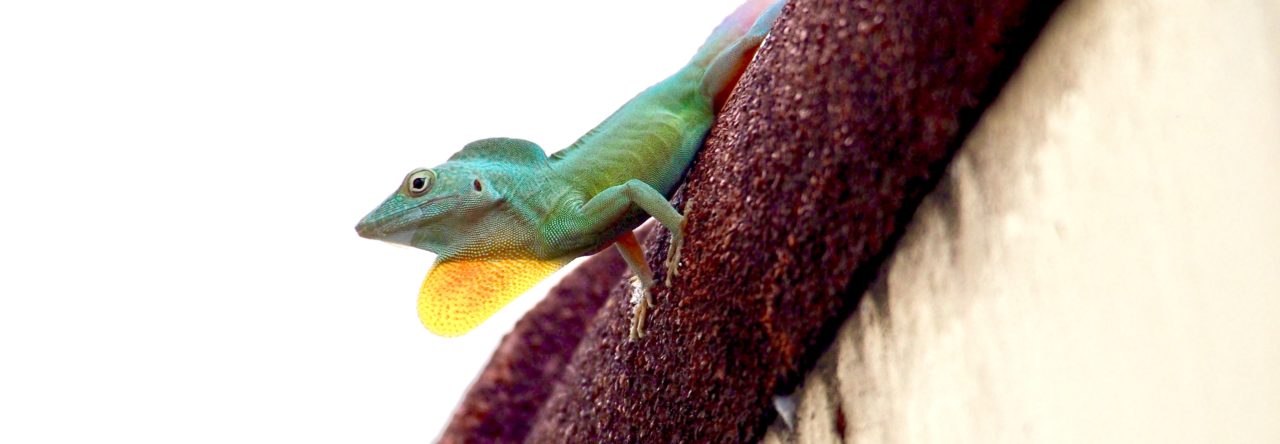In a recent paper in The American Naturalist, Martha Muñoz, Johanna Wegener, and Adam Algar noted an interesting pattern in two clades of Caribbean anoles evolving independently on Cuba and Hispaniola: high elevation species tended to have smaller body sizes than lower elevation species*.

Figure 1: Body size-elevation relationships in Hispaniolan (cybotes clade) and Cuban (sagrei clade) anoles. The x-axis is elevation in meters (on the log scale). The y-axis is SVL, or snout-vent length, a measure of size. The colors represent individual species within each clade; grey represents A. cybotes and A. sagrei on Hispaniola and Cuba, respectively.
Having found that the two groups converged independently on a similar evolutionary pattern, the authors wanted to know: was the underlying evolutionary progression also the same?
To answer this question, the authors took advantage of the fact that the two clades harbored multiple species. By measuring body size-elevation patterns within each species, and then asking how those patterns combined with interspecific patterns to create the overall body size-elevation cline (SEC) observed across all species, Muñoz & Co. could discern subtle differences between clades in the evolutionary trajectory towards convergence. For example, one clade might build its overall size-elevation cline by having the same SEC relationship present in each species, with species also sorting themselves by elevation and size (Model H1). Whereas another clade might build its size-elevation cline just through interspecific differences in size and elevation, without an SEC relationship within species (Model H2).

Figure 2: Two models, of eight that the authors proposed, which might explain how body size-elevation clines evolve. Within-species clines are represented by different colored/dashed lines. Across-species clines are best visualized by drawing an imaginary line through average size and elevation of each species . In H1, each species has the same size-elevation relationship (i.e., the negative slope) and is found at different elevations. This creates a size-elevation relationship that depends on both intra- and interspecific patterns. In H2, each species has no size-elevation relationship (i.e., the flat slope) but is found at different elevations. Here, the size-elevation relationship is driven purely by interspecific differences in elevation and size.
The authors developed eight models for how elevation and size might be related within species and across species. They tested which of those eight models best explained variation in the relationship between size and elevation within species and clades, while accounting for spatial autocorrelation among collection localities and differences in elevational range among species . They then compared best models across clades to see whether convergence was reached by similar or different evolutionary pathways.
What did they find?

- Figure 3: Intra-specific size-elevation clines (SECs) for Hispaniola (left panel) and Cuba (right panel). Solid lines represent significant SECs; dashed lines represent non-significant SECs.
On Hispaniola, each species tended not to show any significant intraspecific SEC relationships: note the flat slopes of the dashed lines in the left panel of Figure 3. Instead, much of the overall SEC comes from interspecific differences in size and elevation, consistent with Model H2 (Figure 2).
On Cuba, in contrast, the authors found some significant within-species SEC relationships–the solid lines in the right panel of Figure 3–but found that interspecific differences in size and elevation explained very little of the clade’s overall SEC (Figure 4)**.
Thus the authors answered their question: “Although the precise mechanisms underlying inverse size[-elevation] clines remains unknown, it is clear that they were constructed in different ways on Cuba and Hispaniola.” In other words, the two clades show a pattern of convergence to small size, but they took different routes of intra- and interspecific evolution to get there. It reminds me of Yogi Berra’s response when asked directions to his house: “When you get to the fork in the road, take it!”
CITATION: M.M. Munoz, J.E. Wegener, and A.C. Algar. 2014. Untangling Intra- and Interspecific Effects on Body Size Clines Reveals Divergent Processes Structuring Convergent Patterns in Anolis lizards. The American Naturalist 184: 636-646.
* This pattern was measured from 16 Anolis species: nine in the sagrei clade (Cuba) and seven in the cybotes clade (Hispaniola). The finding of small body size at high elevations is the inverse expectation of Bergmann’s rule. Bergmann’s rule, as originally conceived, states that endothermic species living in colder climates should be larger (or have a larger surface area to volume ratio), all else equal, to conserve heat. As lizards are ectothermic, one would expect an inverse Bergmann. Perhaps we could call the inverse cline Nnamgerb’s rule? It does have a certain charm to it, no?
** I wonder if the authors might chime in in the comments section. What does it mean that a size-elevation cline wasn’t found on Cuba when using the mean size and elevation of each population (Fig 5 below), but it was found when species identity was ignored (Fig 1 above)? Is this an example of Simpson’s paradox?
- DNA Sequencing from Formalin-Preserved Specimens - December 16, 2014
- Sans the Claws, Anoles Present Under The Trees? - December 5, 2014
- Out Damned Spot! Or, How They’d Be Loving If They Weren’t Fighting - November 18, 2014




Skip Lazell
Cool! Lotsa ConvEv in the Lesser Antilles too.